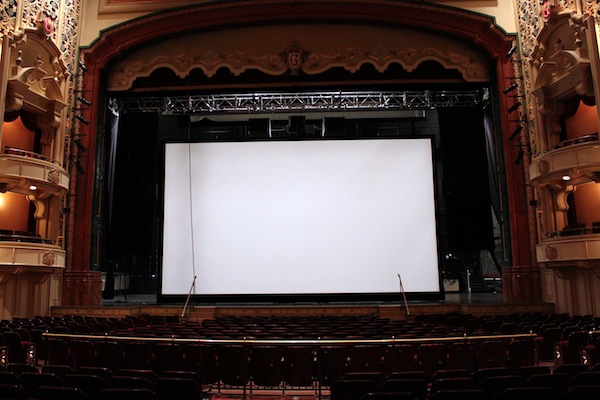The Santa Barbara Center for the Performing Arts recently completed the addition of a Digital Cinema rear-projection system and a 30-foot screen plus five loudspeakers at the 1,550-seat Granada Theatre.
- AMT Systems supplied and installed the new cinema audio equipment, which includes seven Powersoft K Series amplifiers fitted with KDSP digital signal processing and KAESOP networking cards to drive the new 5.1 system’s LCR plus LFE channel loudspeakers.
- “We added EAW QX596i three-way, bi-amped boxes for left, center, and right,
- and two EAW SB2001 subwoofers,” said senior systems engineer, AMT Systems, Mike Shelton.
- Because the new cinema system uses a Christie Digital Systems rear projector, the left and right channel speakers were flown to either side of the Stewart screen while the center channel speaker and dual subwoofers were suspended immediately above the screen.
- Two Powersoft K2 DSP+AESOP amplifiers power the passive coaxial high- and mid-frequency compression drivers in the three QX596i cabinets. Three K3 DSP+AESOP amps drive the four 12-inch low frequency speakers in each of the three boxes. Two K10 DSP+AESOP amps power the twin SB2001 dual-21-inch subwoofers, which carry the low frequency effects (LFE) channel.
- Kyle Ridenour of acoustical, AV, and IT consultancy McKay Conant & Hoover in Scottsdale, AZ, was the consultant on the project. NEP’s American Hi-Definition division, located in Van Nuys, CA, supplied the Digital Cinema projector and screen.
- “A Dolby Labs CP750 digital cinema processor is taking all the audio from the Doremi Labs ShowVault video server and decoding it out to the 5.1 channels,” AMT's Shelton said. "The LCR and LFE channels are distributed to the Powersoft amplifiers, while the left and right surround channels are sent to the theatre’s previously installed Meyer Sound Constellation system. The slew rate and power capacity of the Powersoft amplifiers gave the speaker system remarkable impact and effortless dynamic range. What was also really nice about using the Powersoft amplifiers was that we used all of the DSP in the amplifiers to tune the speakers, set the crossovers and get the room flat. That made it really simple to do the X Curve processing in the Dolby processor.”
- The X Curve, an ISO and SMPTE standard, was developed in order to normalize motion picture audio playback.
- “If you take the Dolby processor out of the signal chain the room is tuned to be flat through the amplifier processing,” said AMT's Shelton. “We do the cinema-specific tailoring in the cinema processor with two different presets. One is set up for the X Curve; that's your typical cinema EQ. Then we have another preset that is for material that wasn't mastered for cinema release; that’s a more natural EQ curve.”
- “When we delivered the amps I built a preset group that included all the EAW Greybox setting for every possible combination of speaker loads and installed them into each of the amps,” says Paul Hugo of Marshank Sales.










